 Image search results - "Yasukuni" Image search results - "Yasukuni" |

Yasukuni Shrine is Japan's most prominent shrine for the war dead. Near Kudanshita Station on the Tozai Subway Line. This is the first giant torii
|
|

Yasukuni Shrine during the Mitama Matsuri before dark.
|
|

Path to shrine
|
|

Yasukuni Shrine's main torii during Mitama Matsuri
|
|
|
|

Promenade to the shrine
|
|

Statue of Omura Masujiro (1824-1869) 大村益次郎, founder of Japan's modern army. Also pushed for the establishment of Yasukuni Shrine.
|
|

Spotlights create a silhouette of the statue of Omura Masujiro (1824-1869) 大村益次郎, founder of Japan's modern army.
|
|
|
|

A bon dance around the base of the statue.
|
|

Second torii
|
|
|

You wash your mouth hands here. Built in 1940 by Japanese living in the US. 大手水舎
|
|
|

Gate built in 1934. 神門
|
|

Spotlights hit the torii.
|
|

Back view of second torii
|
|

At night, 30,000 lanterns light up. A real summer spectacle.
|
|

Imperial crest on gate door
|
|

The lanterns are lit by lightbulbs, not candles.
|
|
|
|
|

Cherry blossom path to shrine
|
|

Tanabata streamers festoon the gate.
|
|
|
|
|

Noh stage and the cherry tree used as the barometer for Tokyo's cherry blossom blooming condition.
|
|

At 6:30 pm, a mikoshi portable shrine was paraded along the promenade.
|
|

Yasukuni Shrine, Torii and Haiden hall
|
|
|

Yasukuni Shrine, Haiden hall. After the Class-A war criminals (such as Hideki Tojo) were enshrined here, the late Emperor Hirohito (Showa) never worshipped here again. 拝殿
|
|
|

On Aug. 15, the anniversary of Japan's surrender and the end of World War II, Yasukuni Shrine is a busy with worshippers and police. These are police buses.
|
|

Police bus.
|
|

From Kudanshita Station to the first torii, the path is jammed with political activists not even related to the war or shrine.
|
|

Rising Sun flag
|
|

On Aug. 15 at Yasukuni Shrine, you can see former soldiers and nationalists dressed in military uniform marching in the shrine.
|
|
|
|
|

On Aug. 15 at Yasukuni Shrine, you can see former soldiers and nationalists dressed in military uniform marching in the shrine.
|
|
|

On Aug. 15 at Yasukuni Shrine, you can see former soldiers and nationalists dressed in military uniform marching in the shrine.
|
|
|
|
|
|

They march up to the end of the line of worshippers lined up to pray at the shrine. Then they turn around and head back.
|
|
|

Worshippers at Yasukuni Shrine on Aug. 15.
|
|

Worshippers at Yasukuni Shrine on Aug. 15.
|
|
|

Worshippers at Yasukuni Shrine on Aug. 15.
|
|

Praying at Yasukuni Shrine on Aug. 15.
|
|
|

Heavyweight judo Olympic gold medalist Satoshi Ishii (石井 慧) was also at Yasukuni Shrine on Aug. 15, 2009. He was very kind and signed autographs, shook hands, and took photos with a lot of people.
|
|
|
|
|
|
|
|
|
|

One of the giant spotlights used to accent the mikoshi, torii, and night sky.
|
|

Noh stage
|
|
|
|
|

After the mikoshi, the Nebuta float and haneto dancers make an appearance.
|
|

Yushukan war museum 遊就館
|
|
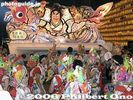
Rassera-rassera!
|
|

Entrance to Yushukan war museum 遊就館
|
|

Yushukan war museum 遊就館
|
|

Nebuta float and haneto dancers. Also see the video at YouTube.Mitama Mtasuri at Yasukuni Shrine.
|
|

Inside Yushukan war museum. Impressive, but its version of Japanese war history is skewed. No exhibit on the Pearl Harbor attack either. 遊就館
|
|

Awa Odori dancers also performed.
|
|

Inside Yushukan war museum: Photos of the war deceased. Look carefully and you may find photos of Hideki Tojo and co.
|
|
|

Yushukan war museum 遊就館
|
|
|
|
|

Nebuta close-up
|
|

Memorial for military dogs which died.
|
|

Nice to see a bit of Aomori in Tokyo.
|
|

After the Nebuta made its way in front of the shrine, a short prayer was held.
|
|

Memorial for military horses which died.
|
|
|

Yushukan war museum 遊就館
|
|

Mother Statue 母の像
|
|

The shrine
|
|

Memorial for sunken naval warships
|
|

The Nebuta then went back to the promenade.
|
|

Memorial for Justice Radhabinod Pal, an Indian judge during the war crimes tribunal. He was a judge who voted for the innocence of Japan's war criminals.
|
|
|
|

Lanterns
|
|

Monument for kamikaze pilots who died.
|
|
|

Memorial for military horses and dogs which died.
|
|

The lanterns are written with the names of the donors.
|
|
|
|

参集殿
|
|

Stage entertainment is also provided during the festival.
|
|

Rest house
|
|
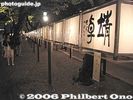
The bigger lanterns have artwork. Some of them were done by celebrities.
|
|

Garden 神池庭園
|
|

Path to the Yushukan war museum.
|
|

Garden 神池庭園
|
|

Yushukan war museum
|
|

Entrance to sumo arena.
|
|

Next to the museum was a display of different lanterns, including a Neputa (left) and Nebuta (right).
|
|

Entrance to sumo arena
|
|
|

Sumo arena. An exhibition sumo tournament is held every April.
|
|
|
|

慰霊の泉
|
|

Neputa is from Hirosaki, Aomori Pref.
|
|

Food stands
|
|

Neputa closeup
|
|

Adding to the dignity of the shrine is a monkey show.
|
|
|
|

Food stall
|
|
|

At Yasukuni Shrine, sign indicating that sumo will be held on April 17, 2023. Sumo has been held at Yasukuni Shrine annually since 1869 to console the spirits at the shrine. It's part of the shrine's religious ceremonies and festival in spring.
|
|

Yasukuni Shrine is dedicated to Japan's war dead. Another vertical sign promoting the sumo exhibition.
|
|

Yasukuni Shrine.
|
|

Entrance to Yasukuni Shrine's outdoor sumo arena.
|
|

Shrine building used by the sumo wrestlers as their dressing room.
|
|

Statue of sumo wrestlers at the entrance of Yasukuni Shrine's sumo arena. The shrine has a large outdoor sumo arena with a capacity of 6,000.
|
|

On April 17, 2023, sumo exhibition matches with professional sumo wrestlers was held for the first time since 2019 after a four-year absence due to the pandemic. Free admission.
|
|

The sumo exhibition started at 8:30 am and ended at around 3 pm. It included demonstrations of comical sumo, sumo taiko drum beating, and ring-entering ceremonies by Juryo and Makunouchi Division wrestlers including Yokozuna Terunofuji. Free admission.
|
|

Walked around the sumo ring to see where I could sit. It was quite full, but I managed to find a space to sit. If you want the best views, should get there by 10 am or so.
|
|

It's rare to see an outdoor sumo arena in Japan. In Nov. 1918 when the Kokugikan sumo arena was destroyed by fire, the sumo tournaments were held here for two years.
|
|

When I arrived, they were performing the sumo jinku folk singing. 相撲甚句
|
|

The hanamichi path where the sumo wrestlers go to/from the sumo ring. Fortunately, it never rained this day. The sumo matches can still be held in light rain.
|
|

Sumo jinku singing. 相撲甚句
|
|
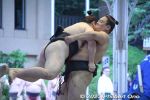
This is shokkiri or comedic sumo. Two lower ranking wrestlers do things normally not allowed in sumo. Spitting at each other, kicking, fighting with the referee, etc. 初切り
|
|

Calling the wrestler.
|
|
|

Juryo Division ring-entering ceremony or dohyo-iri.
|
|

Enho is popular. 炎鵬
|
|

Enho 炎鵬
|
|
|

The ring-entering ceremony is when you can see the designs on the wrestlers' colorful ceremonial aprons.
|
|
|
|
|
|
|
|
|
|
|
|
|
|
|
|
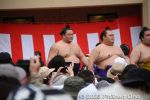
Asanoyama at the end.
|
|

Makunouchi Division ring-entering ceremony or dohyo-iri.
|
|

Asanoyama
|
|

Juryo wrestler Kitanowaka facing frontward. 北の若
|
|

Takayasu, former Ozeki. 高安
|
|

Makunouchi Division ring-entering ceremony or dohyo-iri.
|
|
|
|
|

Hiradoumi has a nice kesho mawashi. 平戸海
|
|
|

Endo has a kabuki kesho mawashi ceremonial apron.
|
|

Yokozuna Terunofuji heads to the sumo ring to perform his dohyo-iri ring-entering ceremony.
|
|

Yokozuna Terunofuji approaching the sumo ring.
|
|

Good to see Terunofuji after four tournament absences. He plans to compete in the May 2023 summer tournament in Tokyo.
|
|
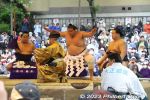
Yokozuna Terunofuji performing the dohyo-iri ring-entering ceremony. He was absent in the last four tournaments. Finally back in the ring.
|
|

Yokozuna Terunofuji performing the dohyo-iri ring-entering ceremony. 照ノ富士
|
|
|

Yokozuna Terunofuji performing the dohyo-iri ring-entering ceremony. 照ノ富士
|
|
|
|

Yokozuna Terunofuji performing the shiranui-style dohyo-iri ring-entering ceremony. 照ノ富士
|
|

Yokozuna Terunofuji performing the dohyo-iri ring-entering ceremony. 照ノ富士
|
|
|

Terunofuji has the shiranui-style yokozuna rope with double loops on the back. 不知火型
|
|

Matches between top division wrestlers started at 2 pm. All the wrestlers had one match.
|
|

Asanoyama who has been climbing back up the ranks. 朝乃山
|
|

Asanoyama. They went through the motions of receiving the water. but there was no water. Not a real tournament.
|
|

Ura 宇良
|
|

Aoiyama is from Bulgaria. He once reached Sekiwake. 碧山
|
|

Aoiyama 碧山
|
|
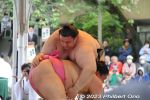
Aoiyama 碧山
|
|

Aoiyama 碧山
|
|

Takayasu 高安
|
|

Endo, one of the most popular wrestlers. 遠藤
|
|
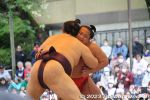
Since this isn't a real sumo tournament, the wrestlers often wrestle while smiling and doing antics they don't normally do.
|
|

Mitakeumi, a former Ozeki. 御嶽海
|
|

Mitakeumi, a former Ozeki. 御嶽海
|
|

Mitakeumi, a former Ozeki. 御嶽海
|
|
|

Daieisho 大栄翔
|
|

Tobizaru (翔猿) means "Flying Monkey."
|
|

Kotonowaka. His father and stable master was also a sumo wrestler named Kotonowaka. 琴ノ若 傑太
|
|

Kotonowaka vs. Daieisho 大栄翔
|
|

Smiling Kotonowaka.
|
|

Empty water ladle, and no spitting.
|
|

Hoshoryu 豊昇龍
|
|
|

Yokozuna Terunofuji getting ready for his match. 照ノ富士
|
|
|
|
|
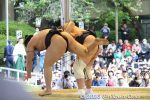
Yokozuna Terunofuji wins his match.
|
|
|

Yokozuna Terunofuji returns to his dressing room.
|
|
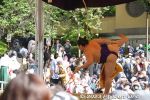
Ritual ending the day's sumo at around 3 pm.
|
|

Spectators exiting the sumo arena. Before, spectators had to bring their own picnic mats to sit on. Now they provided a mat over the entire ground
|
|

They immediately dismantled the sumo ring's dressing.
|
|

Main torii when entering Yasukuni Shrine.
|
|

Base of the black torii. Pretty new paint job.
|
|
|
|
|
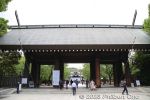
Main shrine straight ahead. The outdoor sumo arena is on the right of the main shrine.
|
|

Cherry trees all finished blooming by mid-April.
|
|
|
|